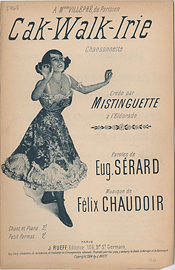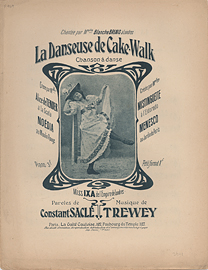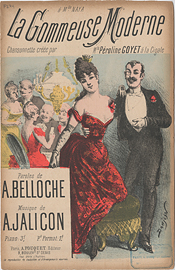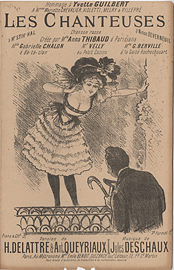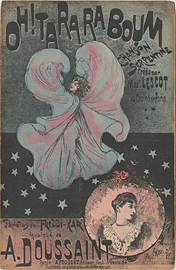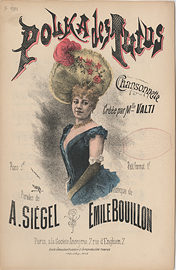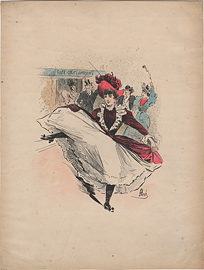Leaning against the wall, she stretches her hamstrings a little and vaguely calculates that she has danced at the Eldorado in the afternoon performance, in the evening performance, and that she will waltz until dawn: seven hours of the waltz and of the cakewalk, without including the undressing, dressing, putting on and removing makeup. She was starving when she arrived; a large glass of beer, gulped down in the “artists” changing room, managed to suppress her appetite – all the better, she thought; I must not put on weight…
– Colette, L’envers du music-hall (1913, 25).
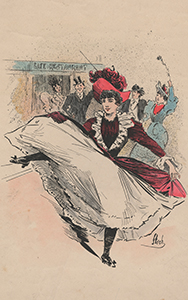 Women took centre stage at music-hall spectacles, where popular singers, actresses, and dancers performed to huge crowds. The “tour de chant” persisted, and during these years singers developed recognizable performance “genres,” gestural styles that emphasized their physicality. Popular genres for female singers included: the pierreuse, the gommeuse, and the épileptique. The pierreuse, resembling a haggard street prostitute, performed realist songs, while the gommeuse, a modern woman dressed in revealing, yet elegantly outlandish clothes, was an immensely popular fin-de-siècle type. The épileptique, by contrast, performed in jerky movements that Rae Beth Gordon (2009) interprets as typifying frenzied Parisian life and evoking the gestures of hysteria documented by neurologist Jean-Martin Charcot. Singer Emilie Bécat introduced the épileptique in 1875, although music-hall stars Polaire and Mistinguett later claimed to have invented the genre. According to Gordon, the amalgamated gommeuses épileptiques with “short dresses and extravagant hats or coiffures were one of the biggest draws in Parisian night-life” (2009, 36).
Women took centre stage at music-hall spectacles, where popular singers, actresses, and dancers performed to huge crowds. The “tour de chant” persisted, and during these years singers developed recognizable performance “genres,” gestural styles that emphasized their physicality. Popular genres for female singers included: the pierreuse, the gommeuse, and the épileptique. The pierreuse, resembling a haggard street prostitute, performed realist songs, while the gommeuse, a modern woman dressed in revealing, yet elegantly outlandish clothes, was an immensely popular fin-de-siècle type. The épileptique, by contrast, performed in jerky movements that Rae Beth Gordon (2009) interprets as typifying frenzied Parisian life and evoking the gestures of hysteria documented by neurologist Jean-Martin Charcot. Singer Emilie Bécat introduced the épileptique in 1875, although music-hall stars Polaire and Mistinguett later claimed to have invented the genre. According to Gordon, the amalgamated gommeuses épileptiques with “short dresses and extravagant hats or coiffures were one of the biggest draws in Parisian night-life” (2009, 36).
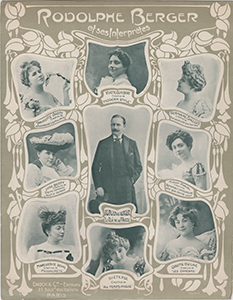 Rodolphe Berger and his singers The sexualized female body was integral to the music hall. Performances included full pantomime-ballets with dancers who were scantily clad or dressed—such as in military uniform—to accentuate their figures (Gutsche-Miller, 2015). While music halls featured chorus girls performing unison high kicks, the Moulin Rouge was home to cancan legends Grille d’Égout and La Goulue, whose provocative dancing thrilled Parisians. Women were not just displayed on the stage; they commanded the halls and promenoirs as well, as writers Huysmans, Zola, and Maupassant have described. While bourgeois women watched the spectacle from the audience, courtesans, known as cocottes de promenoir, strolled along the walkways surrounding the hall, attracting the male gaze and picking up clients. As Gutsche-Miller notes, “the promenoir at times vied with the stage as the evening’s spectacle” (2015, 12). Not surprisingly, the actresses, singers, and dancers of the music halls and vaudeville theatres were often associated with sexual promiscuity. Moreover, the performers and the courtesans who frequented the venues were popular topics for songs, many of which play out these associations through salacious innuendos.
Rodolphe Berger and his singers The sexualized female body was integral to the music hall. Performances included full pantomime-ballets with dancers who were scantily clad or dressed—such as in military uniform—to accentuate their figures (Gutsche-Miller, 2015). While music halls featured chorus girls performing unison high kicks, the Moulin Rouge was home to cancan legends Grille d’Égout and La Goulue, whose provocative dancing thrilled Parisians. Women were not just displayed on the stage; they commanded the halls and promenoirs as well, as writers Huysmans, Zola, and Maupassant have described. While bourgeois women watched the spectacle from the audience, courtesans, known as cocottes de promenoir, strolled along the walkways surrounding the hall, attracting the male gaze and picking up clients. As Gutsche-Miller notes, “the promenoir at times vied with the stage as the evening’s spectacle” (2015, 12). Not surprisingly, the actresses, singers, and dancers of the music halls and vaudeville theatres were often associated with sexual promiscuity. Moreover, the performers and the courtesans who frequented the venues were popular topics for songs, many of which play out these associations through salacious innuendos.

